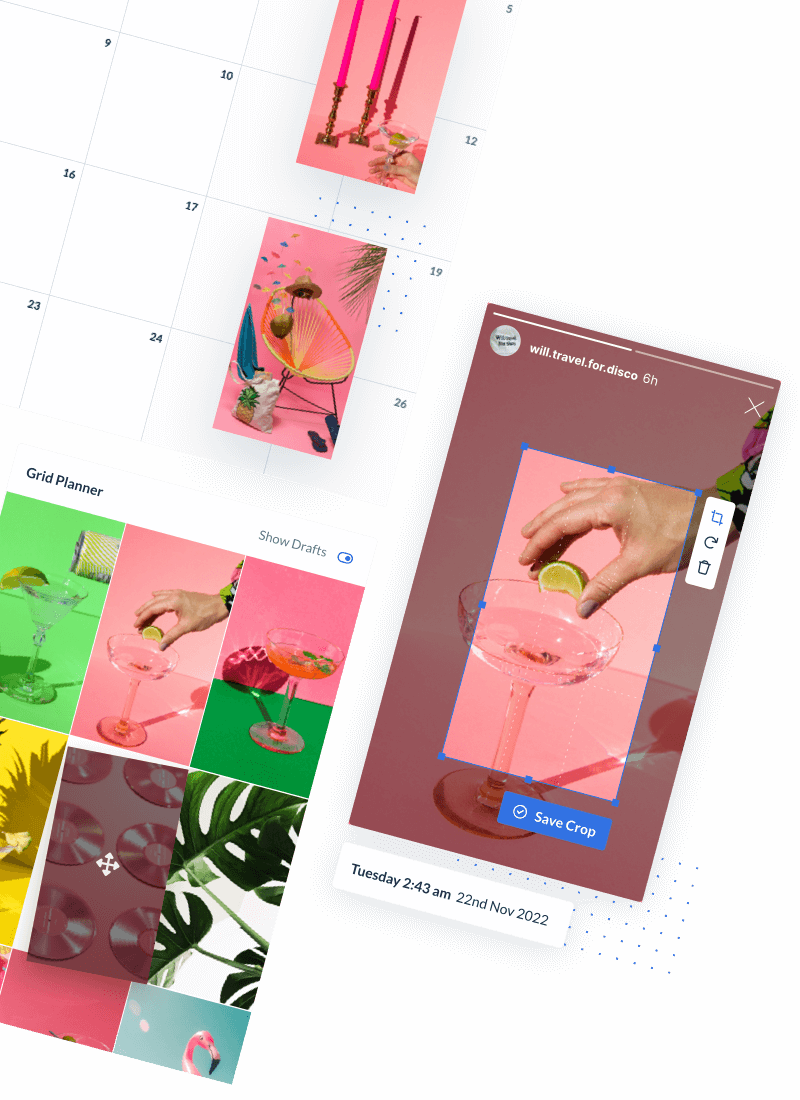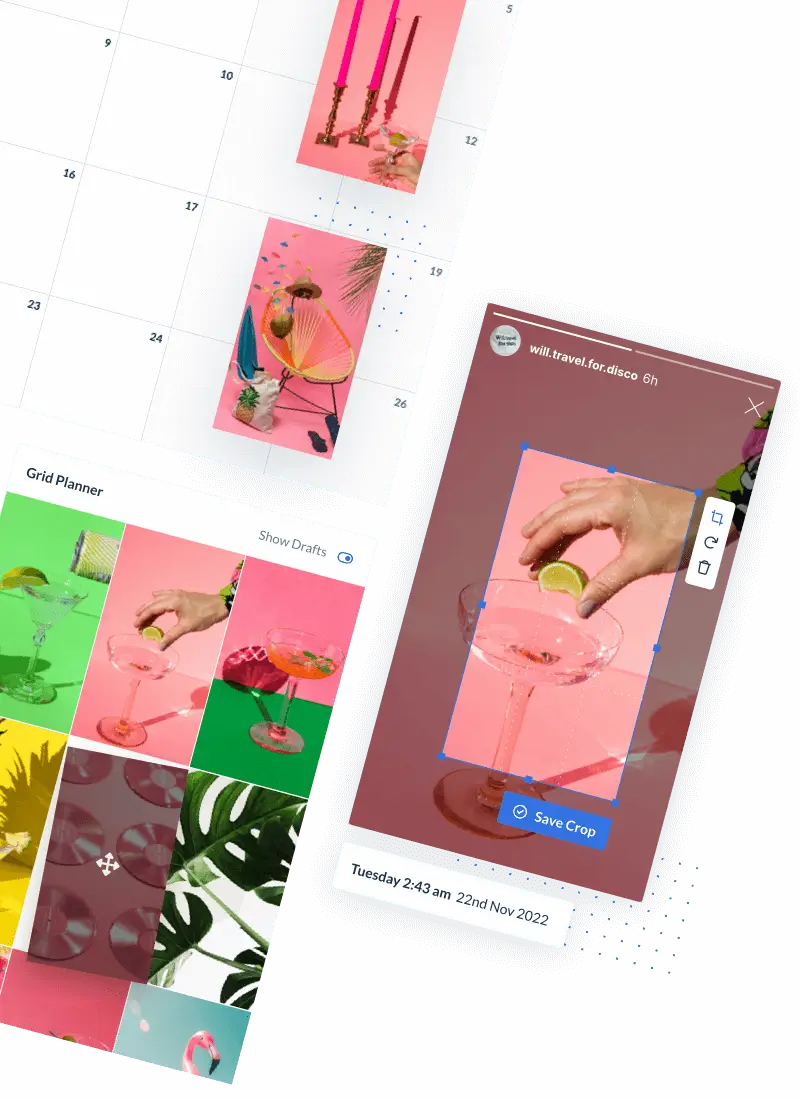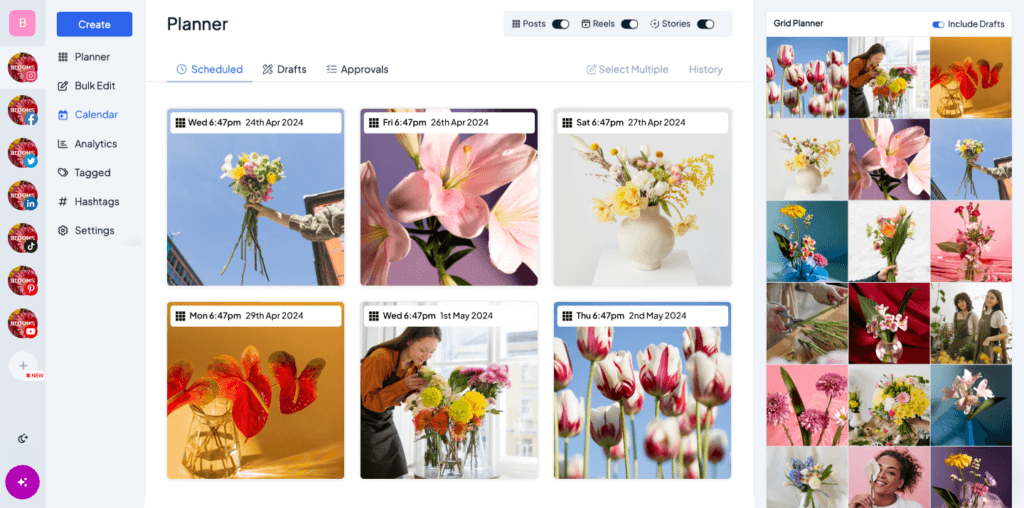Learning how to use Instagram for small business growth can be crucial for success. Instagram is the fourth most popular social media platform in the world, trailing only Facebook, Youtube, and Whatsapp. With nearly 1.5 billion active users, Instagram boasts a wider reach than Reddit, Twitter, and Pinterest combined, making Instagram growth a premiere strategy for your company’s bottom line.
Is your business reaching that massive audience effectively?
Even if you don’t fancy yourself an “influencer,” Instagram growth for your small business can still be powerful. Everything from short-form videos to captioned images can be used and reused, engaging your audience with relevant content they can’t find in many other places.
Take Old Spice’s Dream Runner campaign from 2016 as an example. Instead of simply asking its audience to “like” and “comment” on the posts, they asked people to create a post of their own. More specifically, they asked people to run a route in the shape of one of Old Spice’s prizes and use a GPS to track it on a map. Once they uploaded their picture to Instagram, they then used the hashtag #runoldspice to enter the contest.
Working hand-in-hand with major influencers relevant to its niche, Old Spice was able to raise its brand awareness and promote a new product line. And the Old Spice marketing team did it all by tapping into the natural desire of humans to be part of a community.
That community is what social media is known for, and Instagram provides a creative outlet for your audience to take part. It doesn’t matter if you’re an insta-veteran or an insta-novice, you can leverage Instagram to engage your ideal customer base and grow your follower count quickly with the right approach.
Instagram growth tips for small business
1. Know your platform
You won’t be able to maximize Instagram’s capabilities unless you’re familiar with everything it can do.
Like every other social media platform, Instagram growth is all about content creation and distribution. Even though it’s hemmed in by image and video-based content, you can get extremely creative in how you utilise that media.

Instagram Reels
Instagram Reels, for instance, are short videos that you can overlay with augmented reality, music, and captions. The typical length of a single reel can last anywhere from 15-60 seconds, and you can even create them ahead of time to upload later.
Instagram Stories
Instagram stories are another feature. Whereas you can only share video-based format with Reels, Instagram stories allow you to share text content such as written posts and links. Unfortunately, Stories have a time limit attached to them: After 24 hours, they disappear.
Hopper HQ allows you to schedule instagram stories and instagram reels right from your desktop. Click here to get started and take your Instagram to the next level! 🚀
2. Optimise and get verified
Both Reels and Stories allow you to place links inside your posts to generate external traffic to a website or e-commerce shop. But if you plan on growing your brand, you’ll need to create a fully-fleshed out account, complete with verification and an optimised profile.
With a legitimate online presence, getting verified is quick and easy. Just click on the settings button under your profile tab, and press “request verification” from the account menu. Getting verified ensures that your brand stays protected; anyone who follows you knows they’re not dealing with an imposter.
Optimising your profile is a little more nuanced:
- Remember that your username is different from your account name. Choose an SEO-rich term for your name field that will tell users what you really do
- Fill your bio (don’t stuff, though) with related hashtags and other accounts you’re partnering with. Not only is this a great way to make your account more visible, but you can also grow your audience by establishing partnerships.
- You only get one link in your bio, so make it count. While you may choose to direct your audience to your homepage, you can also use it for an event or promotions page, depending on current efforts on Instagram.
- Don’t forget about messaging! Sliding into someone’s DM’s isn’t just a great way to reach out to celebrities, it can also be perfect for answering customer questions and soliciting feedback.
3. Have a consistent aesthetic
Making sure your brand looks the same from platform to platform is a must. Not only will your brand establish trust with your audience, but it will also make it more memorable. And when a brand is memorable, that means more money added to your bottom line.

So how do you keep your branding consistent across all your channels? It goes beyond simply having the right logo icon, colour palettes and font types. It needs to feel memorable at a glance in the same way that the Golden Arches from McDonald’s makes you instantly understand what you’re seeing (and how it can soothe your hunger).
Consider how your messaging appears on your emails, website, and social media platforms. If your style guide uses a certain type of filter, remember to use it when posting on other channels. Certain tools can help with this; Picsart, for instance, can add quality photo effects to your posts.
💡 Hopper HQ Tip 💡
Hopper HQ offers full image editing within the same tool. You can bulk edit posts to maintain brand consistency and create a beautiful Instagram feed aesthetic.
Visually plan your social content. Instagram, TikTok, Twitter, Facebook, LinkedIn + Pinterest
4. Post user-generated content or write user stories
Deciding how often to post on Instagram can change depending on how many followers your account has. Most experts argue that a business with 1,000–250,000 followers should shoot for somewhere between 2-3 times a day.
That can get tiring. To help build up a portfolio of content — and increase engagement — you should strongly consider posting and sharing content generated from your audience. This isn’t necessarily user-generated content (although that can be a goldmine as well), but stories that show your product in action from a consumer.
A shoe shop, for instance, can share a video of someone running the Boston Marathon in its shoes. An offroading retailer can share clips of its customers taking on Moab. And a software company may create a reel highlighting the efficiency benefits of its product from a real-life business.
5. Follow the social media rule of thirds
If you manage your own social media accounts and create your own content, remember to employ the “rule of thirds.”
- One-third of your content should be promotional in nature, featuring your own content or products.
- Another third should be about curating other posts, like industry news, or featuring any user-generated content.
- The last aspect should be about conversation and interaction, asking and answering questions from your customers, etc.
It’s a simple rule that keeps your social media feed from becoming too promotional and sterile.
6. Utilise micro-influencers
Instagram has played a big role in creating a new type of celebrity called “influencers.” In the past, these people would have been referred to as “endorsers,” but the title influencer reflects their ability to “influence” an audience’s purchasing decisions.
Having a top influencer speak about your brand can be a huge boon for your shop. You’ll place your brand in front of potentially thousands of new users, recouping the influencer’s fees and then some.
But upper-echelon influencers can also cost a fortune. Instead, opt for “micro-influencers” that have substantially fewer followers. The upside is that you can find micro-influencers with a small audience, yes, but one that is laser-targeted on your niche. They’re a lot cheaper than other influencers and can attract just as many prospects when you add scale through multiple micro-influencers.
When looking for people to shout out your brand on Instagram, don’t just look at the follower count — check their engagement rates. Is anyone commenting on their posts? What types of content is their audience engaging with? Does the influencer respond to audience comments and questions?
Having one mega-influencer can work for some brands, but establishing relationships with lower-tier influencers is great for long-term growth. Stack enough of them, and they can become a major channel for your brand.
7. Pay attention to social media metrics
In digital marketing, metrics are invaluable. They not only give you benchmarks as to where your business currently is but also written-in-stone goals as to where your company should be. They are the measuring rod for the success of your company, and brands ignore them at their own peril. As Peter Drucker once said, “What gets measured gets managed.”
The “insights” tab on your Instagram account will give you a ton of numbers that you can track and improve. You could also use an Instagram follower counter tool like GetLikes to monitor your stats. Experiment with different posting times and content strategies to see what’s resonating with your audience, and adjust as necessary.
Metrics to measure:
- Average engagement rate
- Follower growth
- Click-throughs
- Reach
Hopper HQ’s social analytics offer insightful data with detailed post metrics and audience insights that increase your engagement, drive traffic, and boost your social media marketing success.
Find the best time to post, track your follower growth, and understand what content works best with post and account analytics.
8. Run contests and giveaways
If you’re looking to increase your followers as quickly as possible, it’s hard to beat a contest. With a minimal investment, you can cause your reach and audience count to skyrocket in a matter of hours. If it’s done correctly, you should also see your engagement go up as well, which can cause a ripple effect for your other posts.
The goal isn’t simply to bloat your vanity metrics, but to find similar audience members that are currently outside your reach. Your current audience members will share it within their network, causing others to discover your brand.
The image editing software Freepik ran a design contest with a top prize of $1,000. As an entry, participants had to follow Freepik’s Instagram account, create a design from the link in Freepik’s bio, and then post the image using the hashtag #WithFreepikCreate.
The results? Over 100 pieces of user-generated content to go along with an increased following and engagement.
Running a contest is almost foolproof. On average, brands that use giveaways grow their accounts 70% faster than accounts that don’t. If you are absolutely against the idea of a contest, consider creating a post that offers a discount to get a short-term boost.
9. Use hashtags
For the uninitiated, hashtags are a way to categorise content on a social media network. Facebook and Twitter both use them to a certain extent, but they’re particularly effective on Instagram, where you can make your content “trend” just by using the right combination of hashtags. If your content starts trending, it’ll find its way into other people’s Instagram feed, broadening your reach without having to spend any money on advertising.
You can include up to 30 hashtags on a regular post, and up to 10 hashtags on a Story. If you google the ideal number of hashtags to use on your Instagram post, you’ll find a lot of conflicting data stating that the ideal hashtag number is somewhere from 8 to 14. According to case studies and research, however, 11 hashtags seem to be the magic number, increasing engagement with each hashtag as you go up to 11, but declining afterwards.
The key is to make it seem natural; the last thing you want to be accused of is hashtag stuffing just to gain views.
There are five main types of hashtags:
- Location hashtags
- Branded hashtags
- Industry hashtags
- Community hashtags
- Descriptive hashtags
Each one of these categories has broad hashtags (such as #texas for geography), and more specific ones (like #easttexas). Ideally, you would use a mix of larger, more generic hashtags, along with more specific ones that are targeted to your niche.
Industry-specific hashtags are always a good idea. For example, if you have an eCommerce store that sells video-based safety equipment such as dash cams or panic buttons, you can use hashtags like #dashcams and #drivesafe. You can also follow the hashtags for your industry to stay up to date with the trends.
Although you will want to stick with the most popular hashtags — i.e., the ones other people are actively searching for — don’t be afraid to experiment with new hashtags. You might be able to catch one that is just starting to gain traction and ride that wave to a larger audience. Also, consider adding extra hashtags as the first comment on your story to gain a few extra slots.
Discover the best hashtags for Instagram & reach more people to grow your audience with our Hashtag tool. Get 1000s of relevant hashtag suggestions in seconds and save them into hashtag lists to easily and quickly get more post impressions.
> Video, gallery & image posts
> Calendar, feed & grid preview
> Instagram, Facebook & Twitter
10. Engage, engage, engage
Social media is all about relationship-building, and Instagram is no exception. If there is a “secret sauce” to catapulting your account to superstardom, regular and genuine engagement is it. Interacting with other people’s posts and comments shows that you’re interested in your community. Tagging popular users and giving shoutouts to dedicated fans will strengthen their loyalty.
NIke is a brand that absolutely nails Instagram (along with virtually every other form of marketing). Their posts combine inspirational stories with product demos and a healthy dose of behind the scenes images. People feel free to not only comment on the material, but share with a friend, which drives virality.
But how are you supposed to engage with your audience while you’re trying to run a business? For starters, dedicate a few minutes at the same time every day to respond to comments and questions. Second, use genuine responses only; canned answers reek of disinterest and will only serve to drive your audience away. Use a social media scheduling tool like Hopper HQ to free up more time for engagement
Instagram growth is possible for your small business in 2022
Even if you’ve never used any kind of social media for your business, Instagram growth can be a great step towards bringing your brand the added awareness it needs to thrive. You can shape your identity and reach a wider audience than ever before while engaging with your community in real, meaningful dialogue.
But to do that, you need to know the platform, focus on engagement, post user-generated content, leverage micro-influencers, and learn to use hashtags to engage your audience.
The real benefit to Instagram growth is the ability to showcase your products and services, especially by placing them in the hands of everyday users. Best of all, you don’t need to be a major brand to find success; small business owners dominate their markets simply by being authentic and relevant.
How will you engage with your community on Instagram? Share your ideas in the comments.
Enjoyed this post? You might also like:
- Your Ultimate Guide to Instagram Carousel Posts
- How to Create a Social Media Strategy for Your Small Business in 8 Steps
- How to Choose The Best Social Media Management Tool for Your Business
FAQs
What is good growth on Instagram?
Aim for 6% -8% Instagram growth per month on average.
Brands doing the work on Instagram can expect an increase of 6% -8% per month. That’s 3 times more than Facebook, Twitter, or Pinterest.
How do I grow my Instagram in 2022?
Get More Instagram Followers on Instagram in 2022 with these tips:
- Know your platform
- Optimise your profile and get verified
- Have a consistent aesthetic
- Post user-generated content or write user stories
- Follow the social media rule of thirds
- Utilise micro-influencers
- Pay attention to social media metrics
- Run contests and giveaways
- Use hashtags
- Engage, engage, engage












